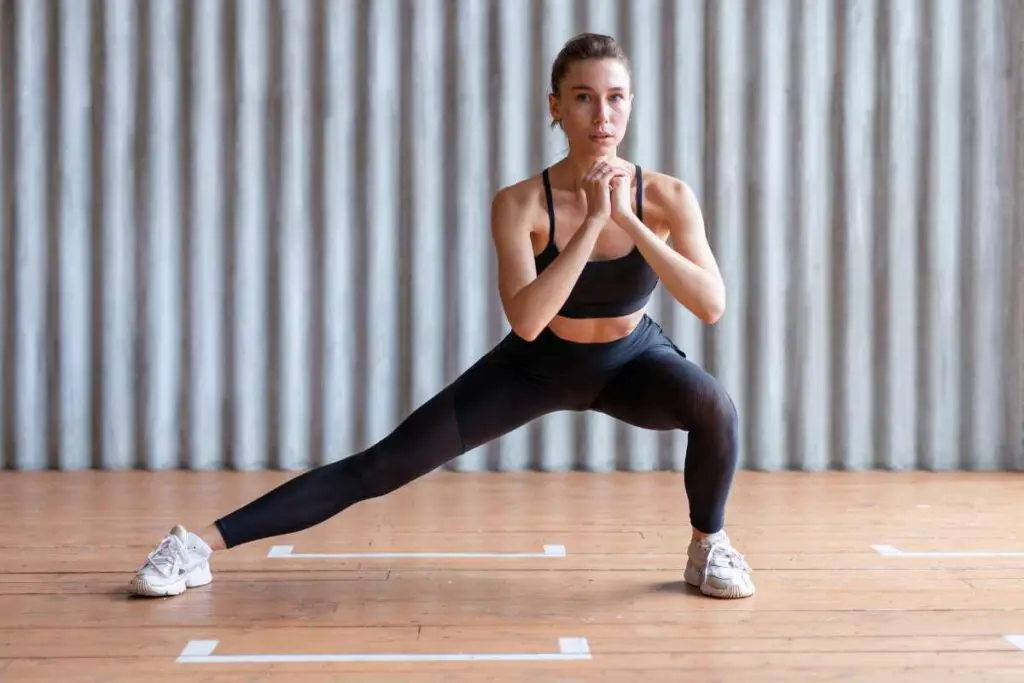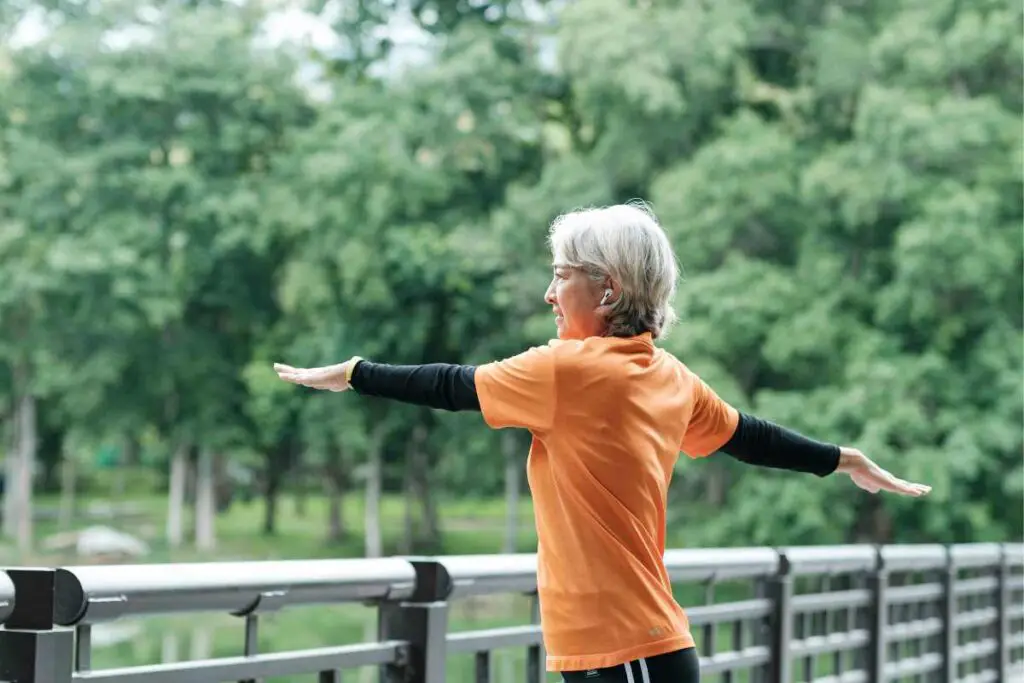For many outdoor enthusiasts, hiking is the perfect opportunity to explore nature and stay fit, but what if you don’t have the time or access to hit the trails regularly?
Fortunately, it is possible to train for hiking without ever setting foot out the door.
This article will examine various exercises and activities that can help increase your strength, endurance, flexibility, and balance, all crucial elements for a successful hike.
By incorporating these training methods into your routine, you’ll be well-equipped to conquer any trail once you do have the chance to embark on a hike.
Understanding the Importance of Physical Fitness for Hiking

Hiking is a popular way to explore the great outdoors, and it requires proper preparation to make the most of your experience.
As a full-body workout, hiking is an excellent way to improve overall fitness and connect with nature. To conquer challenging trails and avoid injuries, it is essential to prioritize physical fitness before undertaking a hike.
Training for hiking not only involves improving cardiovascular endurance but also strengthening various muscle groups.
A strong heart is necessary for maintaining stamina during long hikes, while well-conditioned leg muscles allow you to traverse different terrains with ease. Core strength plays a crucial role in maintaining balance and stability on uneven trails, plus it supports a backpack’s weight effectively.
When preparing for hikes, tailor your fitness routine to encompass different workout categories, including mobility, posterior chain, and core & cardio exercises.
Incorporating jump squats, for example, can help develop power in the lower legs while providing a full lower-body workout. Prioritizing these exercises as part of your training routine will greatly benefit your hiking experience and enable you to tackle more challenging trails in the future.
Training for hiking is about more than just physical fitness; it also includes understanding how to avoid injuries on steep and rocky trails.
Proper footwear, such as well-fitted hiking boots with good traction, is essential for navigating difficult terrain. Staying aware of your surroundings, adjusting your hiking pace accordingly, and listening to your body can help prevent accidents while out on the trail.
In summary, proper training and physical fitness are necessary to optimize your hiking experience and enjoy the great outdoors safely.
Through a combination of cardiovascular exercises, strength training, and injury prevention techniques, you will be well-prepared for various hiking challenges and maximize the benefits of spending time in nature.
Building your Endurance

Cardio Workouts
Incorporating regular cardio workouts into your training routine is essential for building endurance without actually hiking.
Cardiovascular exercises help improve your lung capacity and overall fitness, allowing you to tackle long and challenging trails with ease.
Aim for at least three cardio sessions per week, each lasting 30 minutes or more. Exercises like running, brisk walking, and using an elliptical machine are effective ways to increase your stamina.
Also read – Can Hiking Build Muscle?
Swimming for endurance
Swimming is an excellent full-body workout that can enhance your endurance for hiking. It engages various muscle groups, particularly those on your upper body, which are crucial for maintaining a good posture while carrying a backpack on a trail.
Additionally, swimming enhances your cardiovascular health and lung capacity. To reap the benefits of swimming for hiking endurance, aim to swim at least twice a week. Make sure to include different strokes such as freestyle, breaststroke, and backstroke.
Cycling to build stamina
Cycling is another effective way to build endurance for hiking without actually hitting the trails.
It primarily targets the lower body muscles, such as the quadriceps, hamstrings, and calves, which are essential for maintaining stability and strength during a hike. Furthermore, cycling helps improve cardiovascular health and boosts lung capacity.
To incorporate cycling into your training routine, consider riding your bike or using a stationary bike indoors for 30-60 minutes, three times a week. Mix up your sessions with variations in speed, intensity, and terrain to keep your workouts challenging and engaging.
Strength Training for Hikers

When preparing for a hiking trip, strength training is essential in addition to cardio training.
Building strength in key muscle groups will make your hike more enjoyable and prevent potential injuries.
In this section, we will focus on lower body muscle development, core strength exercises, and resistance training techniques.
Lower Body Muscle Development
The lower body is crucial for hiking as it provides support and stability during your trek.
Some key muscle groups to focus on are the quadriceps, hamstrings, calves, and glutes.
To target these muscles, try incorporating the following exercises into your routine:
- Squats: This compound exercise targets multiple muscle groups in your lower body. Aim for 3 sets of 10-15 repetitions.
- Lunges: Lunges help improve overall leg strength and balance. Perform 3 sets of 10-15 repetitions on each leg.
- Calf raises: Strengthen your calves by performing 3 sets of 15-20 repetitions.
Core Strength Exercises
A strong core is fundamental to maintaining proper posture and balance during a hike.
Core strength exercises not only target your abdominal muscles but also your lower back, hips, and obliques.
Some effective core workouts include:
- Planks: Hold a plank position for 30-60 seconds, focusing on maintaining a straight body and stable core.
- Russian twists: Sit on the ground with your feet elevated, and twist your torso side-to-side while holding a weight. Complete 3 sets of 10-15 repetitions per side.
- Leg raises: Lie on your back and raise your legs, keeping them straight, then lower them without touching the ground. Perform 3 sets of 10-15 repetitions.
Resistance Training Techniques
Incorporating resistance training into your workout routine can help improve overall body strength for hiking.
Resistance bands are an excellent tool as they can easily adjust to your desired level of resistance and target specific muscle groups.
Some resistance training exercises for hikers include:
- Banded squats: Wrap a resistance band around your thighs and perform squats. This adds resistance and engages your outer glutes more effectively.
- Banded side steps: With a resistance band around your thighs or ankles, step laterally for 10-15 steps per side, then repeat in the opposite direction.
- Banded pull-aparts: Hold a resistance band in both hands and stretch the band out in front of you. Slowly pull the band apart, focusing on engaging your back muscles.
Incorporate these strength training exercises into your routine to improve your hiking experience without actually hiking. Remember to progress gradually and listen to your body to avoid overexertion or injury.
Training for Balance and Stability

Balance and stability are essential for hiking on uneven terrain, as they help prevent injuries and ensure a smooth hiking experience.
Training for balance and stability can be done through exercises specifically designed for this purpose.
In this section, we will cover two such training methods: Stability Training for Uneven Terrain and Yoga for Balance.
Stability Training for Uneven Terrain
Stability training helps you improve your footing on uneven surfaces by strengthening the muscles and ligaments required for maintaining balance.
Some exercises for stability training include:
- Single-leg stands: Stand on one foot and maintain your balance for 30 seconds, then switch to the other foot. This exercise can be made more challenging by closing your eyes or extending your arms.
- Bosu ball exercises: Bosu balls are half-sphere balance trainers that can be used for a variety of exercises, like squats and lunges, to enhance stability.
- Lateral Step-ups: Stand next to a bench or step with one foot on the ground and the other on the bench. Step up onto the bench, then step back down, maintaining control and balance.
Remember to perform these exercises regularly to improve your stability on uneven terrain.
Yoga for Balance
Yoga is a great way to enhance your balance and stability while also improving flexibility.
Specific yoga poses can help you train for hiking without hiking.
Some yoga poses for balance include:
- Tree pose (Vrksasana): Stand on one foot, placing the other foot against your inner thigh or calf. Hold for 30 seconds and then switch sides.
- Half Moon pose (Ardha Chandrasana): Balance on one leg with the other extended behind you, reaching for the ground with one hand and extending the opposite arm upwards.
- Dancer’s pose (Natarajasana): Stand on one foot while grabbing the ankle of the other foot and raising it behind you. Extend your free arm in front of you for balance.
Incorporate these poses into your regular yoga practice for enhanced balance and stability during your hikes.
Creating a Comprehensive Hiking Workout Routine

Implementing Bodyweight Exercises
Incorporating bodyweight exercises in your hiking workout routine is an excellent way to build strength and muscle endurance without needing any special equipment.
These exercises rely on your own body weight as resistance, making them practical and effective for at-home workouts.
Some effective bodyweight exercises for training your hiking muscles include:
- Squats: This exercise targets the quadriceps, hamstrings, and glutes – all essential muscles for hiking. Perform 3 sets of 12-15 squats, maintaining proper form with your chest up and looking forward.
- Lunges: Lunges work on the same muscle groups as squats, but with greater emphasis on individual legs. Alternate legs and do 10-12 lunges on each side for 3 sets.
- Push-ups: Hiking can involve some upper body strength, especially when climbing or using trekking poles. Push-ups help improve your chest, shoulder, and tricep muscles. Aim for 3 sets of 10-12 push-ups.
- Plank: Core strength is vital in maintaining balance and posture while hiking. Hold a plank position for 30 seconds to 1 minute, for 3 sets.
These exercises can be done 3-4 times a week to build strength in key muscle groups used during hiking.
Incorporating Pilates
Pilates is another great addition to your hiking workout routine, as it emphasizes the importance of core strength, flexibility, and balance, which are all crucial for long hikes.
Some beginner-friendly Pilates exercises that can enhance your hiking performance include:
- Pelvic curls: This exercise strengthens the lower back and engages your glutes and hamstrings. Lie down on your back with knees bent and perform 8-10 slow curls, lifting your hips off the ground.
- Leg circles: Leg circles promote hip mobility and improve balance. Lying on your back, lift one leg straight up and perform small circles, both clockwise and counterclockwise. Repeat on the other leg, aiming for 8-10 circles in each direction for both legs.
- Swimming: This exercise improves core strength and coordination, simulating a front crawl swimming movement while lying facedown on the ground. Alternate lifting your opposite arm and leg off the ground, with a total of 10-12 lifts per side.
- Side-lying leg lifts: This exercise targets the hip abductors and adductors, which are essential for stabilizing your gait on uneven terrain. Lie on your side and lift your top leg up and down for 10-12 repetitions, then switch sides.
Incorporate these Pilates exercises into your workout routine 2-3 times a week for optimal results in improving your hiking-specific strength and endurance.
Understanding the Role of Environment in Hiking Preparation

When preparing for a hiking adventure, it is essential to consider the environment and how it may impact your training regimen.
The wilderness offers a unique challenge that requires specific conditioning and skills. Incorporating aspects of the natural environment into your training can greatly improve your overall hiking experience and ensure that you are prepared for both day hikes and more extended excursions.
One of the primary factors to consider is the terrain you will be encountering on your hikes. Different types of landscapes, such as rocky trails, uneven paths, or steep inclines, will require various muscle groups and levels of endurance.
By simulating the physical challenges presented by these terrains, you can better focus on strengthening the necessary muscles and improving your overall fitness level. For example, incorporating stair climbing, lunges, and squats into your workout routine can help prepare your body for uphill climbs.
In addition to physical conditioning, it is crucial to familiarize yourself with the specific environmental conditions you may encounter on your hike. Factors such as altitude, weather, and the presence of wildlife will all play a role in your hiking experience.
Research the area where you plan to hike and educate yourself on any potential hazards or unique environmental features. This knowledge will not only improve your hike preparation but also help you remain safe and aware on the trails.
The wilderness provides the perfect setting to experience fresh air and the beauty of nature during your hikes. However, it is important to remember that the great outdoors also presents challenges that require specialized training and knowledge.
To ensure that you are adequately prepared for both day hikes and more extended backpacking trips, be sure to incorporate aspects of the natural environment into your training regimen.
Ultimately, understanding the role of the environment in hiking preparation will help you develop a well-rounded and customized training plan that caters to your specific needs and goals.
By acknowledging the unique challenges presented by the wilderness and incorporating them into your workout routine, you will be better equipped to handle and appreciate the natural world during your hiking adventures.
Flexibility Training

Dynamic and Static Stretches
Incorporating both dynamic and static stretches into your training routine can significantly improve your flexibility and overall hiking performance.
Dynamic stretches involve active movements that help increase your range of motion and warmth in the muscles. Examples of dynamic stretches suitable for hikers include leg swings, arm circles, and walking lunges.
On the other hand, static stretches require holding a position for a certain period, usually around 15-30 seconds, to lengthen the muscles.
These stretches are excellent for cooling down after workouts or hikes. Some effective static stretches for hikers include calf stretches, hamstring stretches, and hip flexor stretches.
The Importance of Proper Form in Stretching
Maintaining proper form while stretching is crucial to preventing injuries and ensuring effective flexibility training.
Some tips for proper stretching form include:
- Warm up before stretching to increase blood flow to your muscles.
- Hold the stretch position steadily, without bouncing or jerking.
- Stretch both sides of the body equally, focusing on symmetry.
- Do not stretch to the point of pain. Stretching should feel challenging but comfortable.
Using Foam Rolling for Muscle Relaxation
Foam rolling is a self-myofascial release technique that uses a foam roller to apply gentle pressure to the muscles, helping in relaxation, muscle recovery, and flexibility improvement.
This technique can be particularly beneficial for hikers, as it helps relieve muscle soreness and tension related to hiking activities.
Some areas to focus on while foam rolling include:
- Calves
- Quadriceps
- Hamstrings
- Glutes
- IT band (outer thigh)
To effectively foam roll, gently roll back and forth over the targeted muscle area, pausing on any tight spots and holding for 20-30 seconds to promote relaxation.
Incorporating foam rolling into your flexibility training routine can aid in easing muscle stiffness and improving overall hiking performance.
Strengthening Joints for Hiking

Strengthening joints, particularly in the lower body, is an essential aspect of training for hiking without actually hitting the trails.
By focusing on exercises that target your knees, hips, and ankles, you can improve stability and reduce the risk of injuries while hiking.
Leg strength plays a crucial role in supporting the joints during hiking. Exercises such as squats, lunges, and step-ups can help build the muscles around your knees, hips, and ankles while also enhancing your overall leg strength.
Find out 🚶 How to Strengthen Knees for Hiking?
These exercises can be performed with or without weights, adjusting the difficulty level according to your current fitness level.
In addition to leg-centric exercises, consider incorporating balance exercises like single-leg deadlifts or yoga poses, such as tree pose and warrior III. These activities can help improve stability, which can benefit your joints and prevent injuries during hiking.
For optimal results, incorporate a combination of dynamic and static stretching to increase flexibility and joint mobility.
Dynamic stretching, such as leg swings or knee raises, should be done before your workout to prepare your muscles for the exercises. After your workout, cool down with static stretches, like hamstring or quad stretches, to lengthen the muscles and prevent stiffness.
Lastly, don’t forget the importance of rest and recovery in joint health. Giving your body adequate time to recover between workouts can help prevent overuse injuries and allow your joints to heal and grow stronger.
Incorporate rest days into your training schedule and consider using joint-friendly recovery tools, such as foam rollers or massage balls, to relieve muscle tension and promote healthy joints.
Mental Preparation and Hiking Mindset

Mental preparation is just as crucial as physical training when it comes to hiking. A strong mindset can help you overcome challenges and enjoy your hiking experience more fully.
One way to train your mindset for hiking is to practice visualization techniques. This involves mentally picturing yourself on the trail, navigating through various terrains, and overcoming obstacles.
Visualization helps create a mental map of your hiking journey, allowing you to feel more confident in your ability to tackle the challenges ahead.
Another aspect of mental training is maintaining a positive attitude. Focus on your goals and visualize your successes instead of dwelling on the potential difficulties.
Remember that challenges on the trail are learning experiences rather than setbacks and remind yourself of the reasons you chose to embark on this adventure.
Additionally, it is essential to practice stress management techniques. Hiking can be physically and mentally challenging, so learning how to cope with stress in a healthy way can help you remain calm and focused on the trail.
Methods such as deep breathing exercises, meditation, and mindfulness can be useful tools for managing stress during a hike.
Similarly, staying motivated and focused during your workouts can also contribute to a strong hiking mindset. Set realistic goals for your training and track your progress along the way.
Celebrate your achievements and learn from your setbacks, as this will help you develop a growth mindset that can be applied to hiking as well.
Incorporating balance and flexibility exercises into your training routine can also enhance your mental preparedness. Practices like yoga and Pilates can improve not only your physical balance but also your mental focus and overall mind-body cohesion.
Lastly, it is beneficial to mimic hiking terrain and practice your hiking skills. You can do this by walking or running on inclines or using a treadmill with an incline feature.
As you become more comfortable with the simulated terrain, you’ll be more confident navigating similar terrains on your actual hike.
In summary, developing a strong hiking mindset involves mental preparation, maintaining a positive attitude, practicing stress management techniques, setting realistic goals, and incorporating relevant exercises into your training routine.
With proper mental training, you can improve your overall hiking experience and tackle challenges with confidence.
Safety Measures for Training and Hiking

When training for hiking without actually hiking, it’s crucial to prioritize safety in your exercises and preparation.
Proper preparation is necessary to prevent injuries and build up your endurance and strength for a successful hiking experience.
During your training, focus on building not only your cardiovascular fitness but also your muscle strength, specifically targeting the muscle groups that you’ll be using during a hike. Incorporate exercises such as squats, lunges, and other resistance training workouts.
It’s essential to gradually increase the intensity and duration of your training sessions, as pushing your body too hard from the beginning can lead to injuries.
Always start with a proper warm-up and stretch before your training sessions to prevent muscle strain.
| Tips for Safe Training | Description |
|---|---|
| Warm-up and Stretching | Engage in dynamic stretches before each training session to prepare your muscles. |
| Progress Gradually | Increase the intensity and duration of your workouts slowly over time to reduce the risk of injury. |
| Mix Cardio and Strength | Incorporate both cardiovascular exercises and strength training in your routine for a balanced workout. |
| Monitor Your Body | Pay attention to any pain or discomfort during your training and adjust your workouts accordingly. |
It’s important to also consider safety measures during the hike, particularly when tackling descents. Proper preparation will aid in reducing the risk of injury.
When descending, take your time and prioritize maintaining a steady pace over speed. Use trekking poles to help distribute your weight and provide stability.
Wearing appropriate footwear with good traction is also essential to prevent slips and falls.
- Proper Footwear: Invest in quality hiking shoes or boots that offer support, cushioning, and grip.
- Proper Pacing: Move at a consistent pace and avoid making jerky movements on steep descents.
- Trekking Poles: Utilize hiking poles for added stability and balance while descending.
By keeping these safety measures in mind during your training and actual hikes, you’ll be better equipped to enjoy your outdoor adventures with confidence while minimizing the chances of injury.
Nutrition and Hydration Considerations for Hikers

Adequate nutrition and hydration play a vital role in ensuring optimal performance and overall health during hiking.
It is essential to focus on consuming energy-packed foods, staying well-hydrated, and adapting your diet according to your training needs.
Nutrition
Opt for nutrient-dense foods that provide the essential macronutrients (protein, carbohydrates, and fats) as well as vitamins and minerals. Some great food choices for hikers include:
- Low-fat yogurt
- Brown rice
- Whole-grain toast
- Pasta
- Fresh fruits and vegetables
Avoid foods that are greasy and high in empty calories, such as fast food. Although it may taste good, it often lacks nutritional value.
For portable and energy-dense options, consider consuming energy bars, gels, bites, chews, and even sports drinks during your hike.
Hydration
Staying well-hydrated is crucial for maintaining energy levels and preventing dehydration-related complications.
- Start hydrating 1-2 days before your hike by consuming at least 8 glasses of water throughout the day.
- Avoid alcohol before a hike, as it can cause dehydration.
- When hiking, the recommended water intake varies depending on factors such as climate, level of exertion, and individual needs. In hot or humid conditions, or when hiking at high altitudes, aim for about one liter of water per hour.
Always carry a water bottle with you and drink water consistently throughout your training sessions and hikes.
By considering these nutrition and hydration tips, you can be well-prepared and energized for your hiking adventures.
Frequently Asked Questions

What exercises can I do at home to prepare for hiking?
To prepare for hiking at home, focus on strengthening leg and core muscles. Effective exercises include squats, lunges, step-ups, calf raises, and planks.
Additionally, incorporate exercises such as bridge and clamshell to target glute muscles. It is important to maintain a balanced workout routine that combines strength and flexibility training.
How can I develop a beginner’s training program for hiking?
A beginner’s training program for hiking should start by focusing on building a solid fitness base. Aim for at least 30 minutes of cardiovascular exercise 3-4 times per week, such as brisk walking, running, or cycling.
Gradually increase the intensity and duration of your workouts. Incorporate strength training exercises, focusing on legs, core, and lower back, 2-3 times per week. Remember to include rest days for recovery and stretch regularly to improve flexibility.
What is the most effective cardio training for hiking?
The most effective cardio training for hiking is one that mimics the activity and challenges the heart and lungs. Uphill walking or running helps build cardiovascular endurance and strengthens the same muscle groups used in hiking.
Stair climbing, either on real stairs or a stair-stepper machine, is also an excellent workout choice. Interval training can improve overall cardiovascular fitness and increase hiking stamina.
How can I improve my hiking stamina?
Improving hiking stamina involves training consistently, incorporating cardio, strength, flexibility, and balance exercises. Gradually increase the duration, intensity, and elevation of your walking or running sessions.
If you can’t hike, simulate uneven terrain by using an incline on a treadmill, climbing stairs, or walking on uneven surfaces. Incorporate interval training or hill repeats to build cardiovascular and muscular endurance.
What are some age-appropriate training plans for seniors?
For seniors, developing a hiking training plan should focus on maintaining functional strength, improving cardiovascular fitness, and preventing injuries. Start slowly and increase workout intensity and duration gradually.
Aquatic exercises can provide low-impact cardio workouts, while strength training can target major muscle groups using resistance bands or bodyweight exercises. Always consult a healthcare professional before starting a new exercise regimen.
How to train for elevation gain in hikes?
To train for elevation gain, focus on workouts that simulate hiking uphill and engage the same muscles required for ascending. Stair climbing, hill walking or running, and incline treadmill sessions are great options.
Strengthen leg muscles, particularly the quadriceps, with exercises like squats, lunges, and step-ups. Additionally, work on core and back muscles to maintain stability and balance while tackling elevation changes.
Find out next 🏔️ How to Get Better at Hiking Uphill





